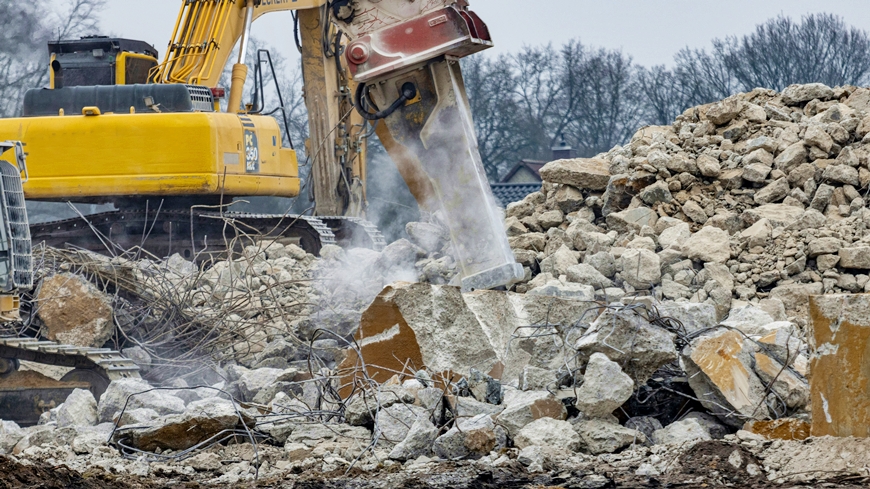Reducing CO2 emissions in concrete production
Recycling cement paste – a cheap and efficient way to curb emissions
Recycling cement paste is one of the cheapest and most efficient ways to reduce emissions from cement production, a new study published recently in PNAS has found. The research, led by experts at Imperial College London’s Department of Civil and Environmental Engineering and including scientists from Empa and EPFL, highlights that waste cement paste that has undergone CO2 mineralization is a cost effective way to reduce emissions from cement.

It found that CO2 mineralization – a process where emitted and atmospheric CO2 is reduced by absorbing it in infrastructure like concrete, bricks, pavers, and clinker substitutes – has the potential to reduce emissions from cement production by 15%, which is the equivalent of 0.8% of global greenhouse gas emissions in 2020.
Of the 10 technologies studied that use CO2 mineralization, the researchers found that recycled cement paste made from demolished concrete was most effective and economical. Cement paste is a glue-like substance that binds materials like sand or gravel together to create concrete. Recycled cement paste typically originates from old infrastructure, like demolished office buildings.
Lead author Rupert J. Myers, from Imperial’s Department of Civil and Environmental Engineering, says: “In the fight against climate change, reducing emissions from the production of cement, and the construction industry more widely, is challenging. Our findings suggest that CO2 mineralized cement paste could be a champion technology in helping us decarbonize the sector.”
Examining company claims
Construction materials are responsible for around 13% of global greenhouse gas emissions – most of which come from manufacturing concrete and steel. Concrete is the second most in-demand material on the planet after water, and this demand is only expected to grow. For these reasons, scientists have been seeking solutions to reduce emissions from concrete and cement production and use.
To carry out the study, the researchers looked at 10 different technologies that claim to effectively mineralize CO2 in cement. They found that only two of the technologies were effective and economical in reducing CO2 emissions from the cement production process.
For most technologies, there was poor or limited evidence that they can reduce CO2 emissions in real-life situations, despite companies claiming that they are effective.
They also found that economical CO2 mineralization-based technologies were between two and five times less expensive than Carbon Capture and Storage (CCS) technologies, where carbon is captured and stored underground.
An added benefit of CO2 mineralization is that it is a permanent solution that is relatively simple to manage. Construction materials can store CO2 for hundreds of years in infrastructure, and possibly longer when demolished materials are recycled.
Co-author Justin D. Driver from the Department of Chemical Engineering says: “Although these findings are promising, it’s important to realize that CO2 mineralization is not a silver bullet solution. There is a limitation on the amount of raw materials available that can absorb CO2, meaning the potential for the technology to reduce emissions across all sectors is also limited.”
And Ellina Bernard, co-author and scientist at Empa's Concrete and Asphalt lab, adds: "This study shows that the wider application of CO2 mineralization by end-of-life concrete (or other calcium-based industrial wastes) is limited by the quantity of materials to be carbonated. However, CO2 savings of 15% in the production of building materials are not negligible. More research is needed to reduce costs and optimize carbon capture and utilization (CCU) technologies." CCU is also at the heart of Empa's new research initiative, Mining the Atmosphere.
Reducing the carbon footprint of cement
The research team, which also includes researchers from Empa (Swiss Federal Laboratories for Materials Science and Technology) and EPFL (Swiss Federal Institute of Technology Lausanne), highlight some important focus areas for policymakers, investors, researchers, and other stakeholders as they seek to reduce emissions from the cement sector:
- Developing policies that support the recycling of demolished concrete, which can then be used for CO2 mineralization technologies, enhancing emissions reductions
- Targeting the CO2 mineralization technologies that are shown to be competitive (spending effort on uncompetitive technologies may be counterproductive to addressing the urgent climate crisis)
- Being transparent about the competitiveness of these technologies, based on the costs to produce it, demand for the product, market share, and use-cases for it, and providing information and labelling that is easy to understand and allows investors to compare across technologies
Dr. Ellina Bernard
Empa, Concrete & Asphalt
Phone +41 58 765 48 88
JG Driver, E Bernard, P Patrizio, PS Fennell, K Scrivener, RJ Myers; Global decarbonization potential of CO2 mineralization in concrete materials; PNAS (2024); doi: https://doi.org/10.1073/pnas.2313475121
News on the website of Imperial College London: https://www.imperial.ac.uk/news/254793/recycling-cement-paste-cheap-efficient-reduce/
-
Share







